Story Ten - Hope Takes flight | |
| Story One | Story Two | Story Three | Story Four | Story Five | Story Six | Story Seven | Story Eight | Story Nine | Story Ten | |
| Visit the main River Returns web site >> | |
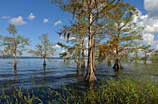 |
Cypress trees stand up to their knees in clean water, surrounding the rim of the aptly named Blue Cypress Lake. Blue Cypress is just north of the vast flat wetlands where the St. Johns River is born. The blue sky and cypress canopy are reflected by the tannic water and give the lake its azure appearance. |
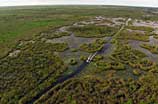 |
An airboat skids across a seemingly endless sawgrass marsh in the headwaters region of the St. Johns River. An aerial view reveals a seemingly monotonous mosaic of shallow water and aquatic plants -- but looks are deceiving: This productive area is teeming with life. |
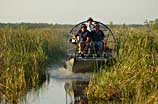 |
The three scientist members of the River Returns film expedition -- David Girardin, Jim Maher and Tom Morris -- near the final destination of the project as they traverse an airboat trail that cuts through the sawgrass marshes of the Upper St. Johns. |
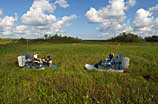 |
The River Returns team takes a break to soak up the quiet that pervades the headwaters region of the St. Johns River. |
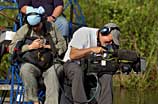 |
River Returns film producers Jill Heinerth, left, and Wes Skiles, right, are literally joined at the camera and figuratively joined at the hip. Close teamwork -- and lots of it -- is key to producing the high caliber of award-winning environmental films that they make. For them, reaching the headwaters is not simply a conclusion to an extraordinary 10-day journey; it's the realization of a long term dream that was years in the making. |
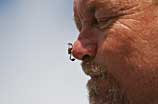 |
A six-legged hitchhiker along our river journey seems to prefer riding on Wes' nose to the houseboat, airboat, canoe, kayak, skiff and flying inflatable boats that the rest of the crew has traveled on. |
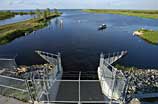 |
Radishes once grew here, at the Farm 13 reservoir, before the St. Johns Water Management District began re-plumbing the area by effectively re-flooding the wetlands. The District built water control structures to create reservoirs for absorbing nutrients from surrounding farms' runoff while at the same time providing an irrigation water resource for the area's citrus groves. |
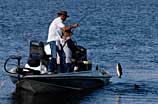 |
A headwaters region reclamation project by the St. Johns River Water Management District has turned farmlands into wetlands and led to the creation of Stick Marsh and Farm 13, a 4-square-mile fishing hole filled with largemouth bass. |
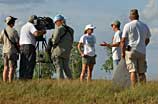 |
Pam Livingston and David Girardin, both employees of the St. Johns River Water Management District, discuss on camera some of the big benefits of the reclamation work done by the District in the headwaters region. Myriad stakeholders stand to gain from turning farmlands back into wetlands, including fishermen, birdwatchers and, last but not least, the river itself. |
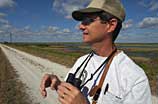 |
If you build it, they will come . . . This aphorism is proving true if you're talking about wetlands and whooping cranes. Marty Folk, a wildlife biologist with the Whooping Crane Reintroduction Project likes hanging out in the Broadmoor Marsh in the Upper St. Johns because a whooping crane has recently found its way here. |
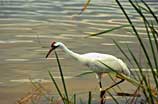 © Florida Fish and Wildlife Conservation Commission |
An adult whooping crane that's a part of the Whooping Crane Reintroduction Project in Florida wades in the shallows looking for food. The adult can be five feet tall. |
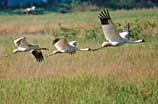 © Florida Fish and Wildlife Conservation Commission |
A family of whooping cranes that are part of the Whooping Crane Reintroduction Project in Florida takes to the air. |
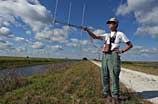 |
A male whooping crane known as No. 772 has settled on the marsh in the Upper St. Johns River basin. The bird is outfitted with a radio transmitter in a colored band around his leg. Marty listens for a radio signal to indicate that the bird is near. |
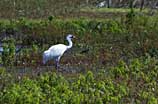 |
More than a quarter of a mile from our closest vantage point, a lone male whooping crane is feeding in the marsh, most likely foraging for snails, snakes and crayfish. This crane stands almost 5-feet tall. |
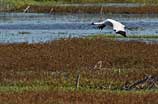 |
Despite that whooping cranes would rather wade than fly, No. 772 takes flight over Broadmoor Marsh, a restored wetland in the Upper St. Johns that has become its newly adopted home. The bird's 8-foot wingspan leads Marty to suggest that it's the jumbo jet of the wading bird species. |
Water's Journey
The River Returns
Stories of the Great St. Johns
The River Returns web documentary, Copyright © Fusionspark Media, Inc. All Rights Reserved.
All Photos © 2005 Russell Sparkman/Fusionspark Media, Inc., unless otherwise noted.
All Photos © 2005 Russell Sparkman/Fusionspark Media, Inc., unless otherwise noted.
